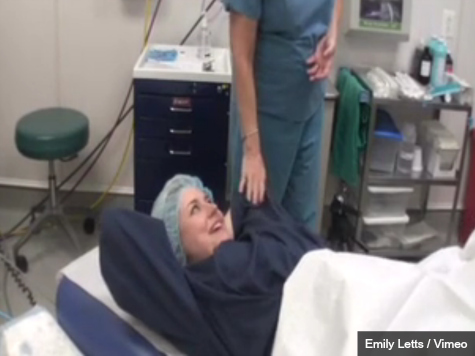Emily Letts, a 25-year-old abortion counselor who works at a New Jersey abortion clinic, decided she wanted to be an inspiration to other women by filming her own abortion.
EMILY’S ABORTION VIDEO from Emily Letts on Vimeo.
A story on Letts from ThinkProgress focuses on her insistence on how pain-free and safe the procedure was – for her.
Of course, it wasn’t so pain-free and safe for the baby, but there is no mention of the baby in the entire article – or, for that matter, his or her father.
Letts published an essay on Cosmopolitan.com describing how wonderful the whole experience was for her. Letts wrote:
We talk about abortion so much and yet no one really knows what it actually looks like. A first trimester abortion takes three to five minutes. It is safer than giving birth. There is no cutting, and risk of infertility is less than one percent. Yet women come into the clinic all the time terrified that they are going to be cut open, convinced that they won’t be able to have kids after the abortion.
ThinkProgress took time to focus on how inaccurately abortion has been portrayed on film and, in contrast, how safe and pain-free it is in reality – again, for the woman:
The few representations of abortion on film are fictional, and they tend to portray it extremely negatively. A recent review of the fictional abortion storylines in TV shows and movies found that the procedure is typically depicted as far more dangerous than it actually is. On the screen, women often die after having an abortion, even though women in real life have virtually zero chance from dying from a legal procedure. Ultimately, pop culture helps further the myth that abortion is always dangerous, dramatic, and violent.
As ThinkProgress points out, the video of Letts only shows the top half of her body, leaving the doctor and her lower torso out of the shot – no reminders of a baby here. When she was finished, she said, “I feel good. I’m done.”
ThinkProgress goes on to add a section detailing how she’s in perfect psychological health; one month after the abortion, Letts says, “I don’t feel like a bad person. I don’t feel sad. I knew that what I was going to do was right – it was right for me and for no one else.”
“And for no one else” – now there’s a Freudian slip if there ever was one.
Letts continued in her essay:
I know there are women who feel great remorse. I have seen the tears. Grieving is an important part of a woman’s process, but what I really wanted to address in my video is guilt. Our society breeds this guilt. We inhale it from all directions. Even women who come to the clinic completely solid in their decision to have an abortion say they feel guilty for not feeling guilty… They pressure themselves to feel bad about it.
ThinkProgress concludes by turning this discussion of guilt into a call to prevent further abortion legislation: “Abortion stigma certainly has an impact on the way that politicians legislate the procedure, so advocates hope that a greater number of women sharing their personal experiences could slowly help politicians make different choices about whether or not to restrict abortion.”

COMMENTS
Please let us know if you're having issues with commenting.